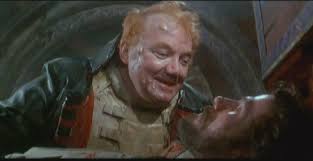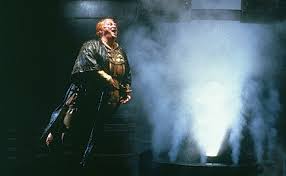Behind The Screen
 |
| I have such WONDERS to show you |
Many GM's struggle with creating a genuinely realistic seeming setting for their players to interact in. The difficulty of keeping things open/unwritten enough for players to explore as they want, while simultaneously having enough written down to keep the game flowing and moving in the direction you want. I've discussed ad-infinitum with many of my gaming buddies that have sat on both sides of the GM screen and have come up with a style that works well for me (which in the end is really what matters, coming up with something that works for you, the GM and your group). I call it Multi-tiered Campaigning.
Essentially what this system does, is allows a GM to not only come up with a story for their game, but work in enough details that, should the players decide to eff-off in their own direction and ignore the over-arching story plot, the game still functions perfectly, with back up plans in place to allow the game-world to advance at pace.
 |
| Plans within plans within plans... Also... WHEEEEEEeeeeee! |
To set this up, one must think in an alternate way than you normally would when creating a campaign. I'm sure you have created a wonderful overarching plot to your campaign. Good. this is essential to the concept. Where this system kicks in is AROUND the central plot. You want to make a many-leveled (tiered) approach to your campaign, not only thinking on the main quest, but also building a believable series of alternate missions for the players to partake in as a break from the main story. Every mission can't be laser-focused on the main plot or else players will grow tired of the game and loose interest, many times feeling like they have little control over what happens in the game as they are rail-roaded towards accomplishing the main goals of the story. With that premis in mind you must then create a series of secondary background adventures (side-quests) for players to work at, should they want to move away from the plot for a breather. Realistically this series of parallel adventures should advance the main storyline only slightly, if at all, but should all have positive or negative side-effects to the main story if they are achieved or failed. Think of this as achievements or rewards. "Congrats on saving the maiden from the ogre, here's a magic sword of ogre slaying". This will, of course, make the players feel like they accomplished something on their own, outside of the main story-arch, but also perhaps give them a bonus later on (maybe the arch-demon final boss has an all-ogre bodyguard no-one knows about... that unrelated story plot really helped out 6 months later huh?).
In my experience, these side-quests work best when used to build relations with others in the game world, allowing players to expand their support base without threatening their hard-earned rewards from the main quest.
Lastly, you'll want to include a tertiary series of events/quests, that happen whether the players interact with them or not. These background events should seem to have no effect on the main quest, to seem totally unrelated in any way, but coalesce into a major plot point near the end of the main quest. This tertiary series of events serve to bring life to the game world, to make it seem like it's a living, breathing entity that moves at it's own pace, with or without the players interaction. In addition, this series of events will reward the players heavily if they investigate them, though only in the long run, which gives them a sense of satisfaction knowing their actions have real and lasting impact on the world.
Next time I'm going to go into detail for creating a Multi-tiered Campaign, by walking you, step-by-step through the creation of one!
Until Next time,
Think outside the box.
Bean out~

No comments:
Post a Comment